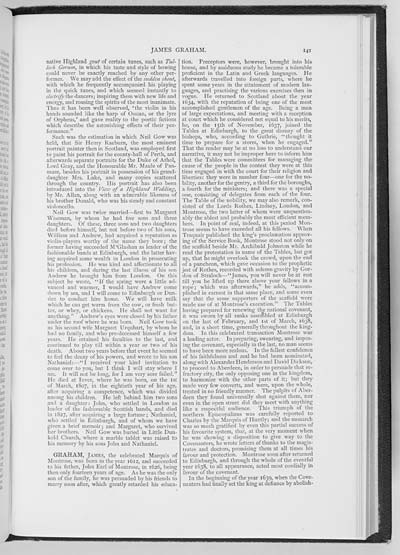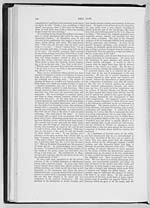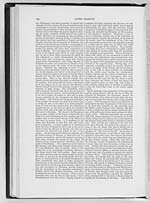141
native Highland gout of certain tunes, such as Tul-
loch Gorum, in which his taste and style of bowing
could never be exactly reached by any other per-
former. We may add the effect of the sudden shout,
with which he frequently accompanied his playing
in the quick tunes, and which seemed instantly to
electrify the dancers; inspiring them with new life and
energy, and rousing the spirits of the most inanimate.
Thus it has been well observed, 'the violin in his
hands sounded like the harp of Ossian, or the lyre
of Orpheus,' and gave reality to the poetic fictions
which describe the astonishing effects of their per-
formance. "
Such was the estimation in which Neil Gow was
held, that Sir Henry Raeburn, the most eminent
portrait painter then in Scotland, was employed first
to paint his portrait for the county-hall of Perth, and
afterwards separate portraits for the Duke of Athol,
Lord Gray, and the Honourable Mr. Maule of Pan-
mure, besides his portrait in possession of his grand-
daughter Mrs. Luke, and many copies scattered
through the country. His portrait has also been
introduced into the View of a Highland Wedding,
by Mr. Allan, along with an admirable likeness of
his brother Donald, who was his steady and constant
violoncello.
Neil Gow was twice married�first to Margaret
Wiseman, by whom he had five sons and three
daughters. Of these, three sons and two daughters
died before himself, but not before two of his sons,
William and Andrew, had acquired a reputation as
violin-players worthy of the name they bore; the
former having succeeded M'Glashan as leader of the
fashionable bands at Edinburgh, and the latter hav-
ing acquired some wealth in London in prosecuting
his profession. He was kind and affectionate to all
his children, and during the last illness of his son
Andrew he brought him from London. On this
subject he wrote, "If the spring were a little ad-
vanced and warmer, I would have Andrew come
down by sea, and I will come to Edinburgh or Dun-
dee to conduct him home. We will have milk
which he can get warm from the cow, or fresh but-
ter, or whey, or chickens. He shall not want for
anything." Andrew's eyes were closed by his father
under the roof where he was born. Neil Gow took
as his second wife Margaret Urquhart, by whom he
had no family, and who pre-deceased himself a few
years. He retained his faculties to the last, and
continued to play till within a year or two of his
death. About two years before that event he seemed
to feel the decay of his powers, and wrote to his son
Nathaniel:�"I received your kind invitation to
come over to you, but I think I will stay where I
am. It will not be long, for I am very sore failed."
He died at Inver, where he was born, on the 1st
of March, 1807, in the eightieth year of his age,
after acquiring a competence, which was divided
among his children. He left behind him two sons
and a daughter: John, who settled in London as
leader of the fashionable Scottish bands, and died
in 1827, after acquiring a large fortune; Nathaniel,
who settled in Edinburgh, and of whom we have
given a brief memoir; and Margaret, who survived
her brothers. Neil Gow was buried in Little Dun-
keld Church, where a marble tablet was raised to
his memory by his sons John and Nathaniel.
GRAHAM, JAMES, the celebrated Marquis of
Montrose, was born in the year 1612, and succeeded
to his father, John Earl of Montrose, in 1626, being
then only fourteen years of age. As he was the only
son of the family, he was persuaded by his friends to
marry soon after, which greatly retarded his educa-
tion. Preceptors were, however, brought into his
house, and by assiduous study he became a tolerable
proficient in the Latin and Greek languages. He
afterwards travelled into foreign parts, where he
spent some years in the attainment of modern lan-
guages, and practising the various exercises then in
vogue. He returned to Scotland about the year
1634, with the reputation of being one of the most
accomplished gentlemen of the age. Being a man
of large expectations, and meeting with a reception
at court which he considered not equal to his merits,
he, on the 15th of November, 1637, joined the
Tables at Edinburgh, to the great dismay of the
bishops, who, according to Guthrie, "thought it
time to prepare for a storm, when he engaged."
That the reader may be at no loss to understand our
narrative, it may not be improper here to inform him
that the Tables were committees for managing the
cause of the people in the contest they were at this
time engaged in with the court for their religion and
liberties: they were in number four�one for the no-
bility, another for the gentry, a third for the boroughs,
a fourth for the ministers; and there was a special
one, consisting of delegates from each of the four.
The Table of the nobility, we may also remark, con-
sisted of the Lords Rothes, Lindsay, Loudon, and
Montrose, the two latter of whom were unquestion-
ably the ablest and probably the most efficient mem-
bers. In point of zeal, indeed, at this period Mon-
trose seems to have exceeded all his fellows. When
Traquair published the king's proclamation approv-
ing of the Service Book, Montrose stood not only on
the scaffold beside Mr. Archibald Johnston while he
read the protestation in name of the Tables, but got
up, that he might overlook the crowd, upon the end
of a puncheon, which gave occasion to the prophetic
jest of Rothes, recorded with solemn gravity by Gor-
don of Straloch�"James, you will never be at rest
till you be lifted up there above your fellows in a
rope; which was afterwards," he adds, "accom-
plished in earnest in that same place, and some even
say that the same supporters of the scaffold were
made use of at Montrose's execution." The Tables
having prepared for renewing the national covenant,
it was sworn by all ranks assembled at Edinburgh
on the last of February, and 1st of March, 1638,
and, in a short time, generally throughout the king-
dom. In this celebrated transaction Montrose was-
a leading actor. In preparing, swearing, and impos-
ing the covenant, especially in the last, no man seems
to have been more zealous. In the fullest confidence
of his faithfulness and zeal he had been nominated,
along with Alexander Henderson and David Dickson,
to proceed to Aberdeen, in order to persuade that re-
fractory city, the only opposing one in the kingdom,
to harmonize with the other parts of it; but they
made very few converts, and were, upon the whole,
treated in no friendly manner. The pulpits of Aber-
deen they found universally shut against them, nor
even in the open street did they meet with anything
like a respectful audience. This triumph of the
northern Episcopalians was carefully reported to
Charles by the Marquis of Huntly; and the monarch
was so much gratified by even this partial success of
his favourite system, that, at the very moment when
he was showing a disposition to give way to the
Covenanters, he wrote letters of thanks to the magis-
trates and doctors, promising them at all times his
favour and protection. Montrose soon after returned
to Edinburgh, and through the whole of the eventful
year 1638, to all appearance, acted most cordially in
favour of the covenant.
In the beginning of the year 1639, when the Cove-
nanters had finally set the king at defiance by abolish-

![]() Universal Viewer |
Universal Viewer | ![]() Mirador |
Large image | Transcription
Mirador |
Large image | Transcription
![]()

